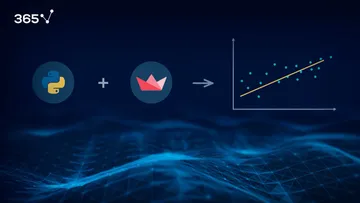If you are looking to break into data science, the good news is that there is no dearth of jobs available. The data industry is booming like never before, and the number of data science job openings is predicted to increase by 28% through 2026.
Unfortunately, there are very few data science degrees offered at an undergraduate level. Most formal programs are only available as Master’s or above, which can be incredibly time-consuming and expensive to complete.
So, if you want to gain skills as a data scientist or machine learning engineer, then a cheaper alternative is to simply take an online course or bootcamp that will provide you with all the necessary knowledge to get an entry-level job. The 365 Data Science program, for example, offers fantastic courses on a range of topics, including Machine Learning in Python, to get you started.
But to make your resume stand out and truly excel in the field, you also need something to show for it. That can be challenging when you have no experience. Don’t worry though, because there’s a solution in the form of machine learning projects.
Table of Contents
- Why Machine Learning Projects?
- Ready-Made Machine Learning Projects
- Top 10 Machine Learning Project Ideas
- Titanic Survival Prediction
- Iris Flower Classification
- House Price Prediction
- The Framingham Heart Study
- Life Expectancy Prediction
- Spam Detection
- Breast Cancer Detection
- Mall Customer Segmentation
- Sentiment Analysis on Movie Reviews
- Pima Indian Diabetes Prediction
- Machine Learning Project Ideas: Next Steps
- FAQs
Why Machine Learning Projects?
Taking on ML projects allows you to apply the knowledge from online courses to a real-world dataset and display it on your portfolio. Take time to explain the steps you took to build the model. If you faced any challenges, then list those too, detailing how you managed to overcome them.
Make sure to highlight these skills at the interview stage as well. This will provide hiring managers with the confidence that you can do the job. It also shows potential employers that you are a motivated individual who has the initiative to build something from scratch.
In this article, I will provide you with 10 beginner-friendly machine learning project ideas. For each example, I will also link to the dataset and a solution created by a fellow data scientist. This way, if you find yourself stuck, you can always refer to another person’s source code to figure out how to proceed.
Ready-Made Machine Learning Projects
Before getting into the ML project ideas, consider one of our various ready-made machine learning projects available directly on our website as part of the standard subscription.
These projects are specifically designed to cater to a diverse range of skill levels, from intermediate to advanced, ensuring that every learner can find a project that fits their current abilities while also pushing them to develop and grow.
The projects we offer span a wide variety of fields, showcasing the versatility of machine learning. Whether you're passionate about the arts and want to explore projects related to music, or you're interested in the fast-paced world of retail, you'll find a project that aligns with your interests.
Each project offers a unique opportunity to apply the theoretical knowledge you've gained to practical, real-world scenarios, further solidifying your understanding and mastery of key concepts.
Additionally, these projects provide tangible evidence of your skills, enriching your portfolio, and making you more appealing to potential employers.
Here are the ML projects we have prepared for you:
- Music Genre Classification Project with PCA and Logistic Regression (Intermediate, Duration: 3 hours)
- Tracking User Engagement with SQL, Excel, and Python Project (Intermediate, Duration: 25 hours)
- Machine Learning for User Classification Project (Intermediate, Duration: 10 hours)
- Regression Analysis in Excel Project (Intermediate, Duration: 4 hours)
- Customer Segmentation in Marketing with Python Project (Advanced, Duration: 5 hours)
We encourage all our learners to take advantage of these resources as they navigate their journey into the world of data science.
Now, let’s explore some ML project ideas you can prepare on your own.
Top 10 Machine Learning Project Ideas
1. Titanic Survival Prediction
Dataset: Titanic — Machine Learning from Disaster
Sample solution: Predicting the survival of Titanic passengers
The Titanic Survival Prediction is undoubtedly one of the most popular machine learning projects for beginners to start out with. It consists of information of over a thousand passengers who were on board the cruise liner when the tragic collision took place.
Inside, you’ll find details such as the passenger’s gender, the number of family members they were traveling with, and their ticket fare. Using all this information, you need to predict whether the given passenger survived.
This is a simple binary classification problem, and you can try a variety of modeling techniques to achieve the highest accuracy possible.
2. Iris Flower Classification
Dataset: Iris Flower Dataset
Sample solution: Machine Learning with Iris Dataset
The Irish Flower Dataset is another well-known machine learning project that presents a classification problem.
It contains three species of Iris flowers, along with information such as sepal length, sepal width, and petal length. With the help of these input variables, you need to predict the class that each flower belongs to.
3. House Price Prediction
Dataset: House Prices Kaggle Dataset
Sample solution: House Prices Solution
The house price prediction dataset consists of 79 variables that describe almost every aspect of residential homes in Ames, Iowa. You need to use these input variables to predict how much these houses cost.
This is a slightly more challenging problem than the previous two on this list, because there is a lot of feature selection and preprocessing that needs to be done. There are too many variables in the dataset, and they have issues like high cardinality and missing values.
You might also need to perform dimensionality reduction techniques, and condense the input to make it interpretable for the machine learning model to ingest.
4. The Framingham Heart Study
Dataset: Framingham Heart Study Dataset
Sample solution: The Framingham Heart Study: Decision Trees
The Framingham Heart Study was a turning point in human understanding of heart disease. In the late 1940s, a large cohort of initially healthy patients between the ages of 30 and 50 was tracked for a period of 20 years. Attributes such as their age, gender, whether they were smokers, cholesterol levels, and BMI were noted.
Over time, some patients developed heart disease, while others remained perfectly healthy. Statistical modeling was conducted for data analysis in order to understand the factors that contributed to this.
A portion of the dataset used in the FHS is publicly available today. It consists of 16 variables of over 3000 patients. Out of those, 15 are independent variables — such as whether they smoke, have high BP, cholesterol levels, and BMI.
Using the data points provided, you need to build a model that predicts whether a patient will develop heart disease in the next 10 years.
5. Life Expectancy Prediction
Dataset: Life Expectancy Dataset
Sample solution: How to predict life expectancy using machine learning
The Life Expectancy Dataset was compiled from data from the United Nations and WHO (World Health Organization).
It contains a list of predictors for different countries— such as the number of infant deaths, reported cases of measles, alcohol consumption, and adult mortality rates. Based on the data points above, you need to predict the life expectancy of each country.
6. Spam Detection
Dataset: SMS Spam Collection Dataset
Sample solution: SMS Spam Detection
The SMS Spam Detection dataset on Kaggle has over 5000 messages in English. Using the content of these messages, you need to predict whether they are legitimate or not.
Legitimate messages are classified as ‘ham,’ while illegitimate messages are classified as ‘spam.’
To learn all about how to do this, try the 365 Machine Learning in Naïve Bayes course that features a practical example about the ‘ham’ and ‘spam’ method of classification.
7. Breast Cancer Detection
Dataset: Breast Cancer Wisconsin Dataset
Sample solution: Breast Cancer Wisconsin Diagnosis using Logistic Regression
In this project, you will use a list of input variables to predict whether a tumor is cancerous. This breast cancer dataset contains details such as its area, texture, perimeter, and radius.
The target variable is called ‘diagnosis’ and there are 2 outputs:
- Class ‘M’, which stands for malignant, indicating that the patient has cancer
- Class ‘B’, which stands for benign, indicating that the tumor isn’t cancerous
Your task would be to predict a patient’s health based on these classes.
8. Mall Customer Segmentation
Dataset: Mall Customer Segmentation Dataset
Sample solution: Customer segmentation with Python
The Mall Customer Segmentation Dataset is the first unsupervised machine learning project on this list. Uploaded on Kaggle, it contains details of mall customers — their age, gender, amount spent, and income.
Using these input variables, you can build a clustering model to separate customers into different groups.
This project has a lot of real-world application since customer segmentation is often conducted by retail stores to improve personalized targeting and come up with recommendations.
If you’d like to learn more on this topic, try out the 365 Customer Analytics in Python course.
9. Sentiment Analysis on Movie Reviews
Dataset: IMDB Dataset of 50K Movie Reviews
Sample solution: Sentiment Analysis on IMDB Movie Review
This dataset consists of around 50,000 IMDB movie reviews. In addition, half of the data is provided for training, and the other half – for testing.
You can train a model on 25,000 movie reviews to predict whether the review is positive or negative.
10. Pima Indian Diabetes Prediction
Dataset: Pima Indian Diabetes Database
Sample solution: Pima Indian Diabetes Prediction
This dataset is originally from the National Institute of Diabetes and Digestive and Kidney Diseases and is now available on Kaggle.
Overall, it has 8 predictors, including a patient’s age, insulin level, and age. Based on these variables, you need to build a model that predicts whether the patient has diabetes.
Machine Learning Project Ideas: Next Steps
Once you complete a few ML projects, you will have a solid grasp of several machine learning workflows, which is a huge step forward in your data science journey. However, your learning doesn’t end there.
While Kaggle datasets are a great place to start, they are a lot easier than machine learning problems you’d encounter in the workplace, because the data is already cleaned, preprocessed, and readily available for modeling.
When working as a data scientist, however, you would often need to collect your own data – this can be messy and unstructured, and you will need to perform a lot of preparation before you can even begin. Moreover, you’re going to need some business analytics knowledge as well, as data scientists are often expected to solve business tasks with the help of available data. If you’re entirely new to the field, you’ve still got a few steps to go before you can achieve your goals.
Are you ready for the next step toward a career in data science?
The 365 Data Science Program offers self-paced courses led by renowned industry experts. Starting from the very basics all the way to advanced specialization, you will learn by doing with a myriad of practical exercises and real-world business cases. If you want to see how the training works, start with our free lessons by signing up below.
FAQs







